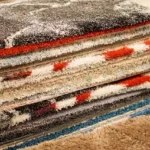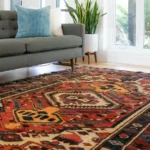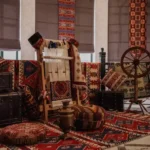Among oriental carpets, Nain rugs from central Iran reflect excellence in artisan construction and time-honored designs. Woven of the world’s finest wool in the region’s high desert climate, Nain carpets bring old-world Persian style blended with the mellowed patina of history to home décor.
History of Nain Rugs
The city of Nain has been a Nain rug and Nain carpet weaving capital for centuries. Nain’s dry desert climate proved ideal for spinning wool and handknotting these Nain Persian carpets. Production flourished particularly in the 19th century. As Nazmiyal Antique Rugs shares, global trade and rising European interest in exotic decorative arts enabled Nain Persian rugs to garner acclaim in exhibitions from Vienna to Chicago for masterful technique and intricate traditional Persian motifs applied through vibrant natural dyes.
Types of Nain Persian Carpets
Most authentic Nain rugs derive from six tribal workshop lineages, namely:
Juibareh – Known for pastel colors and ivory backgrounds
Tiraz – Characterized by vibrant reds and blues
Darab – Muted palettes dyed from regional fruits and flowers
Sir Minai – Finely hand-knotted using lambs wool
Arabzadeh – Intricate curvilinear patterns, often signed
Hazarabady – Densely hand-knotted with artisan precision
Tuteshk – Derived from the town of Tuteshk
Isfahan Nain – Woven in the Nain style but originating from Isfahan
Material and Texture
True Nain carpets use high-altitude lambs wool and occasionally silk fiber, selectively handspun to specifications. Yarn pliability facilitates wefting wool warp and weft foundations at densities averaging 300 knots per square inch. Only the strongest yet most elastic sheep undercoat suffices, hand-combed and naturally dyed using regional flora like madder and minerals. Rinsing in Nain’s naturally alkaline Gavkhouni springs adds softness and sheen. Resulting textures feel fluid, resilient and soothing underfoot.
Weaving Techniques
Nain looms feature two weft rows woven after every knot row. This laborious density protects rug integrity. Designs emerge organically as artisans knot by knot rather than from restrictive graphs. Borders tend traditional Herati and Serated leaf shapes or broken vine hooks. Medallion centers predominate rather than allover coverage. Lambswool pile averages 4-7 millimeters tall. Finer 15th century revival reproductions require over 10,000 knots per square meter. Such nuances distinguish Nain pedigree.
Designs and Patterns
Common motifs derive from cultural symbols like the Tree of Life, regional wildlife or botany. Stylized peacocks, partridges, gazelles, mythical beasts, ripe pomegranates and harmonic palmettes recur in balanced repetition against ivory fields. Infinitely more varied than printed simulations, slight deviations in color gradation and pattern alignment betray Nain rugs’ artisanal handcrafted provenance. Their organic elegance only enhances with patina from decades of finger-rubbed use.
Today commercial demand threatens traditions in rug weaving strongholds like Nain yet respect for regional practices fortunately endures thanks to patrons who value human artistry. Like nowhere else, Nain’s carpets exhibit refined techniques passed down over generations while reinventing enduring tribal icons into nuanced decorative narrative. Centuries later, glimpses of Persian cultural heritage repeat softly underfoot.



